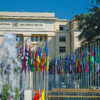It was a big idea: the internet, a global network bringing together the scientific and cultural expertise of an entire planet. Social media, linking social groups and individuals and introducing the method of swarm intelligence in the form of orientation in a complicated world.
Photo: Camilo Jimonez, Unsplash
At the beginning of the 21st century, these achievements are viewed with a certain scepticism. Worse, there is a suspicion that the new media are poisoning rather than changing modern life, entrapping individuals either in the narcissism of the “selfie,” permanent self-expression, or in ubiquitous forms of identity politics.
Not infrequently, the growing number of depressives is explained by the fact that the flood of information and images has taken on unhealthy proportions and tends to lead to an escape from reality rather than a healthy perception of the human condition. The statistics of media use show that we spend an ever-increasing amount of time in front of our smartphones and computers.
Before attempting a classification, one should realise that the innovations of technology are mostly to be classified beyond good and evil. What is a blessing on the one hand is a curse on the other. Under the heading of digital health, thousands of medical professionals cooperate internationally for the benefit of the sick, while the image of the transparent patient introduces a play on words that indicates the danger of these developments.
Criticism of the new media has a long tradition in Germany. Already at the beginning of the last century, Walter Benjamin wrote a fundamental text. The Work of Art in the Age of its Technical Reproducibility introduces the revolution caused by progress in the field of photography and film art. The philosopher refrains from making a final judgement, not only expecting the change of viewing habits, of cognition in general, but already anticipating the political-social potential of media use. Benjamin, who fled from the National Socialists, is clear that the possibility of moving images is used by ideologies.
He notes that the work of art has always been copied, but that technical reproducibility opens something new. It finally loosens art’s original attachment to religious ritual and radically changes the way we perceive the senses. In his view, reproduction eliminates one thing: the here and now of the work of art – its unique existence in the place where it is. Reproduction substitutes the mass-like for a single occurrence and thus becomes politically useful.
The consequences are ambivalent. What atrophies in the age of reproducibility of the work of art, for example, Benjamin laments, is its aura. What he means by this can be checked in his own digital image database. We collect countless images of the things and events we perceive and record; in the process, one not only quickly loses track, but often loses the understanding of when something happened in front of our cameras and why. It is difficult to link the recurring images, if we look at them again at all, to a specific time of origin. In social media, images of private or public catastrophes and events get lost in an uncanny randomness.
The growing number of videos and small clips also remind us of a bon mot by the cultural critic Georges Duhamel: “I can no longer think what I want to think. The moving images have taken the place of my thoughts.” Parallel to this analysis, one must bear in mind the scientifically proven realisation that most media users hardly take note of longer texts anymore, only react to emotions and adopt the standards from the digital world into their everyday life.
In personal encounters, one often encounters contemporaries who know everything and are hardly interested in the other person’s argument in a concrete conversation. It is even rarer to encounter interest when the person you are talking to shows snapshots of his or her holiday trip or city tours. The fact that we are constantly overfed with information and images can be translated into a metaphor that illustrates the problem: our glass is always full.
Benjamin also foresees another revolution in his text: “With the growing expansion of the press, which made ever new political, religious, scientific, professional, local organs available to the readership, ever larger parts of the readership – at first on a case-by-case basis – fell under the writers.” The distinction between author and audience is losing its fundamental character.
This is a phenomenon that the social media are taking to extremes. In the various forums of the internet, every personality mutates into an author, spreads religious theories or gives his or her political opinion. At the beginning, this reality was associated with the idea of democratisation, but today scepticism is growing here, because millions of new authors regularly publish nonsense, false reports and insults.
Is social media changing society for the worse? Before forming a hasty opinion here, it is better to remember the wisdom that any human activity carried out without moderation directly or indirectly makes people ill. But, no doubt, considering the growing amount of time consumers spend on social media, the potential danger can hardly be downplayed.
Keeping track of the whole world and its crises on a second-by-second basis obviously entails the danger of either despairing or being supplied with simplistic truths in a parallel world. Stress, anxiety and panic attacks are, according to science, the price that comes with the overabundance of negative information. In the news magazine Der SPIEGEL, media researcher McLaughlin reported from his study, which confirms that among 1,100 respondents, about 16.5 percent tend to this problematic media consumption.
It should not be forgotten that the use of media often goes hand in hand with the loneliness of the users. There is often a lack of accompanying encounters, conversations that frame the experiences and insights of everyday consumption with each other. The fact that a real situation cannot be replaced by digital media can be seen in the signs of fatigue that the numerous Zoom conferences trigger in us. And anyone who has tried their hand at speaking in a virtual forum will quickly realise how the lack of directly experienced reaction inhibits their own flow of speech.
The same phenomenon will be confirmed by those who hope for a factual or profitable discussion in a social medium. It is no coincidence that this contact usually ends quickly, that people judge and condemn more radically – compared to a direct exchange. The number of virtual enmities is probably greater in this balance than the cases of the beginning of genuine friendship.
Of course, the old principle that intention counts also applies in the field of social media. In addition to the advice of moderation of use, another addition suggests itself here. Those who mobilise for a topic, search for like-minded people or initiate a concrete project will always experience success in the forums. The theory behind this is derived from a thought of the philosopher Slavoj Zizek, who sees the virtual in the sense of a preliminary stage of the real. This mechanism works, depending on the motivation, in a good and a bad dimension. Those who set themselves the goal of using the net for a project or initiating real encounters will have healthier experiences compared to those who only observe the game of the players in an imaginary dream world of absolute truths.
It is time for the Muslim community to think of a new strategy for the creative use of social media. The fascinating potential of mobilisation made possible by the internet is unlikely to be seriously debated. For years, we have succeeded in counteracting the existing negative chains of association around the phenomenon of Muslims in Europe with positive images in the new media. Here are three more examples that we can implement together in the next few years: the re-formation of guilds, the establishment of virtual marketplaces and the financing of trend-setting projects through crowdfunding. The impact of modern technologies is ambivalent, but the bottom line is that we can hope that our good intentions will ultimately prevail.












